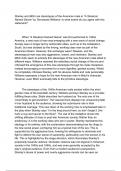Stanley and Mitch are stereotypes of the American male in “A Streetcar
Named Desire” by Tennessee Williams- to what extent do you agree with this
statement?
When “A Streetcar Named Desire” was first performed in 1940s
America, a new race of man was emerging with a new wave of social change.
Society was no longer led by aristocratic elites, such as in the Antebellum
South, but was dictated by the throng, working class man as part of the
American Dream. However, this archetype wasn’t flawless, and the
stereotypical man was also aggressive, violent, and intolerant. Stanley and
Mitch both seem to embody this stereotype of the new American male albeit in
different ways. Williams resented the relentless social change of the era and
criticised the emergence of this new stereotype through his male characters,
instead encouraging a movement to a more dignified, genteel society. Whilst
he completely criticises Stanley, with his abusive habits and rude personality,
Williams expresses a hope for the new American man in Mitch’s character.
However, even Mitch eventually falls to the primitive stereotype.
The stereotype of the 1940s American male existed within the strict
gender roles of the twentieth century. Williams portrays Stanley as a provider,
fulfilling these roles. Stella describes her husband as “the only one of his
crowd likely to get anywhere”. Her assured tone displays her unwavering faith
in her husband to the audience, showing her submissive role in their
traditional marriage. This new dawn of the working man is emphasised later in
the play when Stanley says “I’m the king around here, so don’t forget it. [He
hurls a cup and saucer to the floor]”. The use of the metaphor shows the
shifting attitudes of class in post-war American society. Rather than an
aristocracy, it is the working class who are in power. Stanley represents this
ideology in its entirety, with the exclamation demonstrating how he clings to
his new social power, portraying him as a typical man of the era. This is
supported by his aggressive tone, howling his willingness to dominate and
fight to defend his own sense of superiority, particularly over the women in his
life. This is highlighted by the stage direction, which illuminates Stanley's
propensity towards violence. Domestic violence was not atypical in American
society in the 1940s and 1950s, and was even generally accepted by the
play’s original audience. Even from a modern audience’s perspective,
Stanley’s abuse of power and overly aggressive moods can be seen as
, evidence for his position as a stereotype of American masculinity, regardless
of the time period.
This isn’t the only instance of Stanley's violence, with the most obvious
example being Scene Three’s “poker night”. Stella “backs away… There is the
sound of a blow” at the hands of Stanley. The stage direction ensures that all
domestic abuse occurs off-stage, allowing the audience to imagine their own
personal experiences of violence. Williams writes Stanley in this manner to
enable all audience members to apply his character to the men that they
know, allowing Stanley to stand as a typical symbol of the American male.
Modern audiences still recognise how the female characters in “A
Streetcar Named Desire” are treated as sexual objects, and this belief would
have been even more powerful and prevalent in the highly misogynistic
society of 1940s America. Williams portrays Stanley as a sexually entitled,
arrogant man to criticise such demeaning beliefs using Stanley as a symbol
for stereotypical attitudes towards women. Stanley “sizes women up at a
glance, with sexual classifications”. This stage direction highlights the ease
with which he objectifies the female characters in the play. This escalates to
violence quickly, particularly in Scene Ten, with Stanley’s rape of Blanche.
Stanley alludes to these “sexual classifications” in “we’ve had this date with
each other from the beginning”. This ominous tone suggests to the audience
that Stanley has been waiting for the opportunity to attack his sister-in-law,
representing the climax of the undertone of violence which has underpinned
the entire play. Williams portrays this violent undertone as a typical part of
American life through the relationship between Steve and Eunice, which is
accompanied by “a murmur of thunder”. The pathetic fallacy connotes danger
to the audience, proving that Stanley’s attitudes and actions do not stand in
isolation. This allows Williams to portray Stanley as a symbol of the
stereotypical male, especially since Kazan suggested that “there is a Stanley
in every bar in America”. His violence is commonplace.
Initially, Mitch seems to defy this image of stereotypical, aggressive
masculinity, appearing soft and gentle. He moves “like a dancing bear”, and
the simile suggests his willingness to adapt to Blanche’s more sophisticated
way of life.





